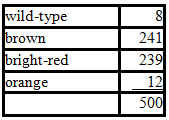An old pine tree in the front yard is beginning to die as the neighborhood deciduous trees have grown. Why might this be?
A) Deciduous trees have depleted the soil of nutrients.
B) The pine tree is shade intolerant.
C) The pine tree has depleted the soil of nutrients.
D) Deciduous trees are shade intolerant.
B
You might also like to view...
Neurons and some other specialized cells divide infrequently because they _____
A) no longer have active nuclei B) no longer carry receptors for signal molecules C) have entered into G0 D) can no longer bind Cdk to cyclin E) show a drop in MPF concentration
In order for the scientists to artificially select Drosophila for their number of bristles,
In the laboratory, fruit flies (Drosophila) were artificially selected for the number of bristles on their bodies. One population (R) was selected for low numbers of bristles, a second population (S) for high numbers of bristles.

A. no change was seen; it's much too soon.
B. some slight increase of bristle numbers was already evident.
C. a vast, overlapping range of bristle numbers was seen.
D. a slight increase in bristles in S, a slight decrease in R, with a little overlap in the middle ranges.
E. a huge increase in S, a huge decrease in R, with no overlap whatsoever.
The mother of these progeny resulted from a cross between two flies from true-breeding lines. What are the genotypes of these two lines?
In Drosophila, the autosomal recessive pr and cn mutations cause brown and bright-red eyes, respectively (wild-type flies have brick-red eyes). Flies who are homozygous recessive at both pr and cn have orange eyes. A female who has wild-type eyes is crossed to an orange-eyed male. Their progeny have the following distribution of eye colors:

A) pr cn+ / pr cn+ and pr+cn / pr+cn
B) pr+cn+ / pr+cn+ and pr cn / pr cn
C) pr+cn+ / pr cn and pr cn / pr cn
D) pr+cn / pr cn and pr cn+ / pr cn
E) More than one of these could be true.
A cloned mammal is made by removing the DNA from the unfertilized egg of an egg donor, replacing it with DNA from a cell of a mature animal, and then implanting that cell into the uterus of a surrogate mother. The cell then divides and behaves as if it were a regular embryo. Answer the following question regarding a clone.Of whom is the baby a clone?
A. Surrogate mother B. Egg donor C. DNA donor D. It depends on whether it is male or female.